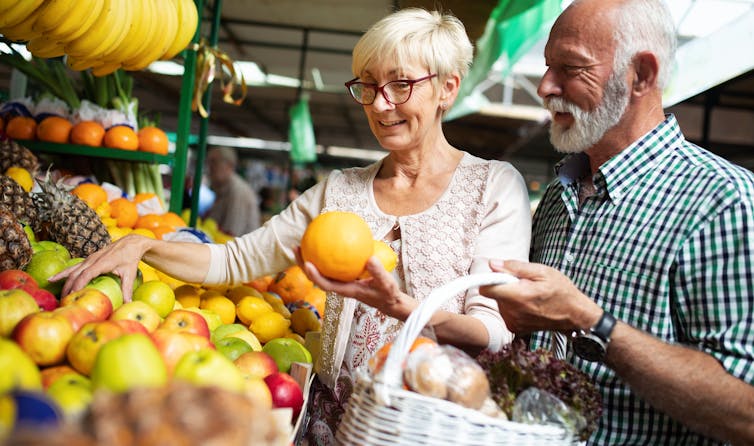Fresh fruit down, junk food up: our modelling suggests Australians’ diets will get worse by 2030

The age-old saying “you are what you eat” rings true – diet quality affects our health from the inside out. While a healthy diet can improve health and wellbeing, a poor diet increases the risk of chronic health conditions such as obesity, diabetes and heart disease.
But Australians’ diets appear to be getting worse, not better. Our new modelling study suggests by 2030, our diets will comprise almost 10% less fruit, and around 18% more junk food. This puts us further away from national targets for healthy eating.
A public health priority
A healthy diet is a priority area of the National Preventive Health Strategy. This strategy sets clear goals to improve diet quality by 2030, including increasing fruit and vegetable intake, and reducing consumption of discretionary or “junk” food.
Junk foods (such as cakes, chips, chocolate, confectionery, certain takeaway foods and sugary drinks) are high in saturated fat, salt and sugar, and should only be consumed occasionally and in small amounts.
The preventive health strategy stipulates adults should be consuming two servings of fruit per day and five serves of vegetables, and should be reducing discretionary foods to less than 20% of total energy intake.
Currently, we’re sitting well short of these targets.
We wanted to know whether we might be able to achieve these goals by 2030. So we combined unique data on Australians’ diets with predictive models to map out how our diets are likely to change by 2030.
The CSIRO Healthy Diet Score survey has been running since 2015. This survey uses short questions to measure intake of the five healthy food groups, including fruit and vegetables, as well as discretionary foods. The questions ask about how often people eat certain foods, and how much they eat, to determine an individual’s average daily consumption.
We analysed data from more than 275,000 people who completed this survey between 2015 and 2023. We used predictive modelling techniques called generalised linear models to forecast future diet trends against the national targets. We also broke our findings down by sex and age.
What we found suggests we’re heading in the wrong direction.

Fruit intake down, junk food up
Overall, we found fruit consumption is declining. On average, Australians were eating 0.1 fewer serves of fruit in 2023 than they did in 2015. If this trend continues, we expect a further 9.7% decrease in the average serves of daily fruit to 1.3 serves per day by 2030, well below national targets.
While vegetable consumption appears steady at around 3.7 serves per day, this is well below the recommended daily intake of 5 serves per day.
Concerningly, we are also seeing an increase in consumption of discretionary foods. Average daily intake increased by 0.7 serves between 2015 and 2023, with a further 0.8 serve increase predicted by 2030 (an 18% rise). That’s a 1.5 serve (40%) increase in just 15 years.
We can’t put an exact figure on how junk food intake stacks up against the targets, because we looked at serves per day, while the targets are about the proportion of total energy. However, the figures we identified constitute significantly more than 20% of total energy intake.
Things look worse for women. By 2030, women are predicted to be eating 13.2% less fruit and 21.6% more discretionary foods compared to 2023. For men, our predictions suggest a 4.8% decrease in fruit intake and a 19.5% increase in junk foods.
Despite a greater change in women, men are still predicted to be eating more discretionary foods by 2030 (6.3 serves per day for men versus 4.6 for women).
For Australians aged 30 and above, both fruit and vegetable intake are declining. Adults aged 31–50 have the lowest reported fruit and vegetable intake, but the largest change is in adults 71 and older. For these older Australians, we estimate a 14.7% decrease in fruit consumption and a 6.9% decrease in vegetable consumption by 2030. That’s equivalent to a decrease of 0.5 serves of fruit and 0.2 serves of vegetables since 2015.

Discretionary food intake is on the rise in all age groups, but particularly in younger adults.
However, young Australians (18–30 years) may be eating more discretionary foods, but they’re also the only ones eating more healthy food as well. Both fruit and vegetable consumption are increasing for young Australians, with our modelling suggesting a 10.7% and 13.2% respective rise in average serves per day by 2030.
Although this is a positive sign, it’s not enough, as these projections still put young Australians below the recommended daily intake.
Some limitations
Our modelling helps us to understand diet trends over recent years and project these into the future.
However, the research doesn’t tell us what’s driving the worrying trends we’ve observed in Australian diet quality. There are likely to be a variety of factors at play.
For example, many Australians understand what a “healthy balanced diet” is, but what we eat could be affected by social and personal preferences.
It could also be related to cost of living and other pressures which can make fresh food harder to obtain. Also, the area where we live can influence how easy or hard it is to make healthy food choices.
Understanding the root causes behind these changes is a vital area of future research.
In terms of other limitations, our study only focused on the diet quality of Australian adults and didn’t investigate trends is children’s diets.
Also, we only looked at fruit, vegetables and junk food in this study. But we are currently studying changes in the whole diet, taking in other food groups as well.
What can we do?
Australian diets are going in the wrong direction, but it’s not too late to correct the path. We need to ensure all Australians understand what constitutes a healthy diet, and can afford to maintain one.
While no one person, sector or organisation can do this alone, by working together we can put a greater focus towards eating a healthy diet. This includes reviewing policy around the availability and price of fresh fruits and vegetables, as well as looking at our own plates and swapping the junk food for healthier options.
Danielle Baird, a Team Leader in Nutrition and Behaviour at CSIRO, contributed to this article.![]()
Matthew Ryan, Postdoctoral CERC Fellow, Human Health, CSIRO and Gilly Hendrie, Research Scientist, Human Health, CSIRO
This article is republished from The Conversation under a Creative Commons license. Read the original article.


